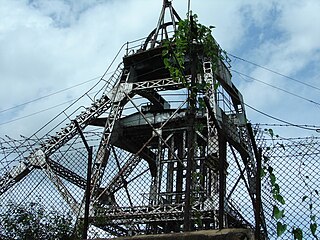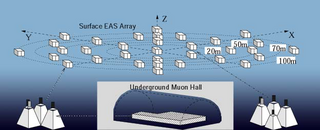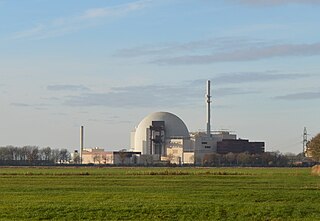
A muon is an elementary particle similar to the electron, with an electric charge of −1 e and a spin of 1/2, but with a much greater mass. It is classified as a lepton. As with other leptons, the muon is not thought to be composed of any simpler particles; that is, it is a fundamental particle.

Cosmic rays or astroparticles are high-energy particles or clusters of particles that move through space at nearly the speed of light. They originate from the Sun, from outside of the Solar System in our own galaxy, and from distant galaxies. Upon impact with Earth's atmosphere, cosmic rays produce showers of secondary particles, some of which reach the surface, although the bulk are deflected off into space by the magnetosphere or the heliosphere.

Neutrino astronomy is the branch of astronomy that observes astronomical objects with neutrino detectors in special observatories. Neutrinos are created as a result of certain types of radioactive decay, nuclear reactions such as those that take place in the Sun or high energy astrophysical phenomena, in nuclear reactors, or when cosmic rays hit atoms in the atmosphere. Neutrinos rarely interact with matter, meaning that it is unlikely for them to scatter along their trajectory, unlike photons. Therefore, neutrinos offer a unique opportunity to observe processes that are inaccessible to optical telescopes, such as reactions in the Sun's core. Neutrinos can also offer a very strong pointing direction compared to charged particle cosmic rays.
Argon (18Ar) has 26 known isotopes, from 29Ar to 54Ar and 1 isomer (32mAr), of which three are stable. On the Earth, 40Ar makes up 99.6% of natural argon. The longest-lived radioactive isotopes are 39Ar with a half-life of 268 years, 42Ar with a half-life of 32.9 years, and 37Ar with a half-life of 35.04 days. All other isotopes have half-lives of less than two hours, and most less than one minute. The least stable is 29Ar with a half-life of approximately 4×10−20 seconds.
Chlorine (17Cl) has 25 isotopes, ranging from 28Cl to 52Cl, and two isomers, 34mCl and 38mCl. There are two stable isotopes, 35Cl (75.8%) and 37Cl (24.2%), giving chlorine a standard atomic weight of 35.45. The longest-lived radioactive isotope is 36Cl, which has a half-life of 301,000 years. All other isotopes have half-lives under 1 hour, many less than one second. The shortest-lived are proton-unbound 29Cl and 30Cl, with half-lives less than 10 picoseconds and 30 nanoseconds, respectively; the half-life of 28Cl is unknown.
Sulfur (16S) has 23 known isotopes with mass numbers ranging from 27 to 49, four of which are stable: 32S (95.02%), 33S (0.75%), 34S (4.21%), and 36S (0.02%). The preponderance of sulfur-32 is explained by its production from carbon-12 plus successive fusion capture of five helium-4 nuclei, in the so-called alpha process of exploding type II supernovas.
Oganesson (118Og) is a synthetic element created in particle accelerators, and thus a standard atomic weight cannot be given. Like all synthetic elements, it has no stable isotopes. The first and only isotope to be synthesized was 294Og in 2002 and 2005; it has a half-life of 700 microseconds.

The IceCube Neutrino Observatory is a neutrino observatory constructed at the Amundsen–Scott South Pole Station in Antarctica. The project is a recognized CERN experiment (RE10). Its thousands of sensors are located under the Antarctic ice, distributed over a cubic kilometre.
In quantum electrodynamics, the anomalous magnetic moment of a particle is a contribution of effects of quantum mechanics, expressed by Feynman diagrams with loops, to the magnetic moment of that particle. The magnetic moment, also called magnetic dipole moment, is a measure of the strength of a magnetic source.

A neutrino detector is a physics apparatus which is designed to study neutrinos. Because neutrinos only weakly interact with other particles of matter, neutrino detectors must be very large to detect a significant number of neutrinos. Neutrino detectors are often built underground, to isolate the detector from cosmic rays and other background radiation. The field of neutrino astronomy is still very much in its infancy – the only confirmed extraterrestrial sources as of 2018 are the Sun and the supernova 1987A in the nearby Large Magellanic Cloud. Another likely source is the blazar TXS 0506+056 about 3.7 billion light years away. Neutrino observatories will "give astronomers fresh eyes with which to study the universe".

The Daya Bay Reactor Neutrino Experiment is a China-based multinational particle physics project studying neutrinos, in particular neutrino oscillations. The multinational collaboration includes researchers from China, Chile, the United States, Taiwan, Russia, and the Czech Republic. The US side of the project is funded by the US Department of Energy's Office of High Energy Physics.

SNOLAB is a Canadian underground science laboratory specializing in neutrino and dark matter physics. Located 2 km below the surface in Vale's Creighton nickel mine near Sudbury, Ontario, SNOLAB is an expansion of the existing facilities constructed for the original Sudbury Neutrino Observatory (SNO) solar neutrino experiment.

The Kolar Gold Fields (KGF), located in the Kolar district of the state of Karnataka, India, are a set of defunct gold mines known for the neutrino particle experiments and unusual observations that took place there starting in 1960. The experiments ended with the closing of the mine in 1992.
The Aberdeen Tunnel Underground Laboratory is a particle physics laboratory in Hong Kong. It is the only underground particle physics lab in Hong Kong. The laboratory is situated between the two vehicular tunnel tubes, behind Gates 2 and 5 of Aberdeen Tunnel on Hong Kong Island.

The GAMMA experiment is a study of:
Muon tomography or muography is a technique that uses cosmic ray muons to generate two or three-dimensional images of volumes using information contained in the Coulomb scattering of the muons. Since muons are much more deeply penetrating than X-rays, muon tomography can be used to image through much thicker material than x-ray based tomography such as CT scanning. The muon flux at the Earth's surface is such that a single muon passes through an area the size of a human hand per second.

The China Jinping Underground Laboratory is a deep underground laboratory in the Jinping Mountains of Sichuan, China. The cosmic ray rate in the laboratory is under 0.2 muons/m2/day, placing the lab at a depth of 6720 m.w.e. and making it the best-shielded underground laboratory in the world. The actual depth of the laboratory is 2,400 m (7,900 ft), yet there is horizontal access so equipment may be brought in by truck.

The LUX-ZEPLIN (LZ) Experiment is a next-generation dark matter direct detection experiment hoping to observe weakly interacting massive particles (WIMP) scatters on nuclei. It was formed in 2012 by combining the LUX and ZEPLIN groups. It is currently a collaboration of 30 institutes in the US, UK, Portugal and South Korea. The experiment is located at the Sanford Underground Research Facility (SURF) in South Dakota, and is managed by the United States Department of Energy's (DOE) Lawrence Berkeley National Lab.

CONUS Experiment is a research project at the commercial nuclear power plant in Brokdorf, Germany. The CONUS project is sponsored by the Max-Planck-Institut für Kernphysik and Preussen Elektra GmbH.
The Waxman-Bahcall bound is a computed upper limit on the observed flux of high energy neutrinos based on the observed flux of high energy cosmic rays. Since the highest energy neutrinos are produced from interactions of utlra-high-energy cosmic rays, the observed rate of production of the latter places a limit on the former. It is named for John Bahcall and Eli Waxman.














